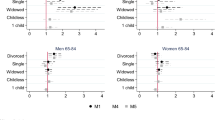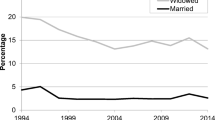Abstract
The purpose of this paper is to examine the hypothesis that marital and poverty status interact in their effects on mortality risks beyond their main effects. This study examines the epidemiological bases for applying an additive rather than a multiplicative specification when testing for interaction between two discrete risk factors. We specifically predict that risks associated with being nonmarried and with being poor .interact to produce mortality risks that are greater than each risk acting independently. The analysis is based on men and women who were ages 25–74 during the 1971–1975 National Health and Nutrition Examination Survey I (NHANES I) and who were traced successfully in the NHANES I Epidemiologic Follow-Up Study in 1982–1984. Overall, being both poor and nonmarried places nonelderly (ages 25–64) men, but not women, at risk of mortality greater than that expected from the main effects. This study shows that for all-cause mortality, marital and poverty status interact for men but less so for women; these findings exist when interaction is assessed with either a multiplicative or an additive standard. This difference is most pronounced for poor, widowed men and (to a lesser degree) poor, divorced men. For violent/accidental deaths among men, the interaction effects are large on the basis of an additive model. Weak main and interaction effects were detected for the elderly (age 65 +).
Similar content being viewed by others
References
Aiken, L. S. and S. G. West. 1991. Multiple Regression: Testing and Interpreting Interactions. Newbury Park, CA: Sage.
Antonovsky, A. 1967. “Social Class, Life Expectancy, and Overall Mortality.” Milbank Memorial Fund Quarterly 45:31–74.
— 1987. Unraveling the Mystery of Health: How People Manage Stress and Stay Well. San Francisco: Jossey-Bass.
Black, D., P. Townsend, and N. Davidson. 1982. Inequalities in Health: The Black Report. Harmondsworth, UK: Penguin.
Carter, H. and P. C. Glick. 1976. Marriage and Divorce: A Social and Economic Study. Cambridge, MA: Harvard University Press.
Catalano, R. 1991. “The Health Effects of Economic Insecurity.” American Journal of Public Health 81:1148–52.
Duleep, H. O. 1986a. “Measuring the Effect of Income on Adult Mortality Using Longitudinal Administrative Record Data.” Journal of Human Resources 21:238–51.
— 1986b. “Incorporating Longitudinal Aspects into Mortality Research Using Social Security Administrative Record Data.” Journal of Economic and Social Measurement (Winter): 126–29.
Duncan, G. J. 1984. Years of Poverty, Years of Plenty. Ann Arbor: Institute for Social Research, University of Michigan.
Feldman, J. J., D. M. Makuc, J. C. Kleinman, and J. Coroni-Huntley. 1989. “National Trends in Educational Differentials in Mortality.” American Journal of Epidemiology 129:919–33.
Gerstel, N., C. Riessman, and S. Rosenfield. 1985. “Explaining the Symptomatology of Separated and Divorced Women and Men: The Role of Material Conditions and Social Networks.” Social Forces 64:84–101.
Goldman, N. 1993. “Marriage Selection and Mortality Patterns: Inferences and FaiIacies.” Demography 30:189–208.
Gove, W. R. 1973. “Sex, Marital Status, and Mortality.” American Journal of Sociology 79:45–67.
Gove, W. R., M. Hughes, and C. B. Style. 1983. “Does Marriage Have Positive Effects on the Psychological Well-Being of the Individual?” Journal of Health and Social Behavior 24:122–31.
Haan M., G. A. Kaplan, and T. Camacho. 1987. “Poverty and Health: Prospective Evidence from the Alameda County Study.” American Journal of Epidemiology 125:989–98.
House, J. S., R. C. Kessler, R. Herzog, R. P. Mero, A. M. Kinney, and M. J. Breslow. 1990. “Age, Socioeconomic Status, and Health.” Milbank Memorial Fund Quarterly 68:383–411.
House, J. S., K. R. Landis, and D. Umberson. 1988. “Social Relationships and Health.” Science 241:540–45.
Kaprio, J., M. Koskenvuo, and H. Rita. 1987. “Mortality after Bereavement: A Prospective Study of 95,647 Widowed Persons.” American Journal of Public Health 77:283–87.
Kasl, S. V. and J.A. Wells. 1985. “Social Support and Health in the Middle Years: Work and the Family.” pp. 170–98 in Social Support and Health, edited by S. Cohen and L. Syme. New York: Academic Press.
Kitagawa, E. M. and P. M. Hauser. 1973. Differential Mortality in the United States: A Study in Socioeconomic Epidemiology. Cambridge, MA: Harvard University Press.
Koopman, J. S. 1981. “Interaction between Discrete Causes.” American Journal of Epidemiology 113:716–24.
Koopman, J. S. and D. L. Weed. 1990. “Epigenesis Theory: A Mathematical Model Relating Causal Concepts of Pathogenesis in Individuals to Disease Patterns in Populations.” American Journal of Epidemiology 132:366–90.
Koskenvuo, M., J. Kaprio, A. Kesaniemi, and S. Sarna. 1980. “Differences in Mortality from Ischemic Heart Disease by Marital Status and Social Class.” Journal of Chronic Diseases 33:95–106.
Kotler, P. and D. Wingard. 1989. “The Effect of Occupational, Marital, and Parental Roles on Mortality: The Alameda County Study.” American Journal of Public Health 79:607–12.
Litwak, E, and P. Messeri. 1989. “Organizational Theory, Social Supports, and Mortality Rates: A Theoretical Convergence.” American Sociological Review 54:49–66.
Makuc, D. M. and J. C. Kleinman. 1986. “Survival Analysis Using Complex Survey Data: Examples from the National Health and Nutrition Survey Epidemiologic Follow-Up Study.” Paper presented at the annual meetings of the American Statistical Association, Chicago.
Marmot, M. G., M. Kogevinas, and M.A. Elston. 1987. “Social/Economic Status and Disease.” Pp, 111–35 in Annual Review of Public Health, edited by L. Breslow, J. E. Fielding, and L. B. Lave. Palo Alto: Annual Reviews, Inc.
National Center for Health Statistics. 1987. Plan and Operation of the NHANES I Epidemiologic Follow-Up Study 1982–84. Washington, DC: GPO.
Pearlin, L. 1985. “Social Structure and Processes of Social Support.” Pp. 43–60 in Social Support and Health, edited by S. Cohen and S. L. Syme. Orlando: Academic Press.
— 1989. “The Sociological Study of Stress.” Journal of Health and Social Behavior 30:241–56.
Pearlin, L. and H. A. Turner. 1987. “The Family as a Context of the Stress Process.” pp. 143–65 in Stress and Health: Issues in Research Methodology, edited by S. V. Kasl and C. L. Cooper. New York: Wiley.
Rosen, S. and P. Taubman. 1982. “Healthiness, Education, and Marital Status.” Pp. 20–40 in Economic Aspects of Health, edited by V. R. Fuchs. Chicago: University of Chicago Press.
Ross, C. E., J. Mirowsky, and K. Goldsteen. 1990. “The Impact of the Family on Health.” Journal of Marriage and the Family 52:1059–78.
Rothman, K. 1976. “The Estimation of Synergy or Antagonism.” American Journal of Epidemiology 103:506–11.
— 1986. Modern Epidemiology. Boston: Little Brown.
Smith, J. C., J. A. Mercy, and J. M. Conn. 1988. “Marital Status and Suicide.” American Journal of Public Health 78:78–80.
Syme, S. L. and L. F. Berkman. 1976. “Social Class, Susceptibility, and Sickness.” American Journal of Epidemiology 104:1–9.
Thoits, P. A. 1982. “Conceptual, Methodological, and Theoretical Problems in Studying Social Support as a Buffer against Life Stress.” Journal of Health and Social Behavior 23:145–59.
Umberson, D. 1987. “Family Status and Health Behaviors: Social Control as a Dimension of Social Integration.” Journal of Health and Social Behavior 28:306–19.
Venters, M.H. 1986. “Family Life and Cardiovascular Risk: Implications for the Prevention of Chronic Disease.” Social Science and Medicine 22:1067–74.
Verbrugge, L. 1979. “Marital Status and Health.” Journal of Marriage and the Family 31:267–85.
Waitzman, N. J. 1988. “The Occupational Determinants of Health: A Labor Market Segmentation Analysis.” Doctoral dissertation, American University.
Weed, D. L., M. Selmon, and T. Sinks. 1988. “Links between Categories of Interaction.” American Journal of Epidemiology 127:17–27.
Zick, C. D. and K. R. Smith. 1991a. “Marital Transitions, Poverty, and Gender Differences in Mortality.” Journal of Marriage and the Family 53:327–36.
— 1991b. “Changes in Economic Status Surrounding the Death of a Spouse.” Journals of Gerontology: Social Sciences 46:S310–20.
Author information
Authors and Affiliations
Additional information
An earlier version of this paper was presented to the Session on Mortality and Marital Status at the 1990 annual meetings of the Population Association of America, held in Toronto. We would like to thank Cathleen D. Zick, David Kiefer, three anonymous reviewers, and the former and current editors of Demography for their helpful comments on earlier versions of this paper. The research reported in this paper was supported in part by the National Institute on Aging (Grant AG06363) and the National Science Foundation (Grant SES-86-18677).
Rights and permissions
About this article
Cite this article
Smith, K.R., Waitzman, N.J. Double jeopardy: Interaction effects of marital and poverty status on the risk of mortality. Demography 31, 487–507 (1994). https://doi.org/10.2307/2061754
Issue Date:
DOI: https://doi.org/10.2307/2061754




